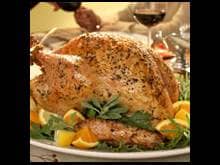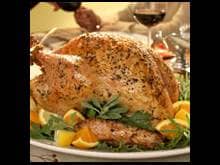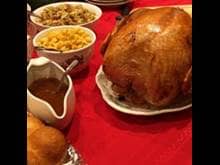
Thanksgiving is all about abundance, or, often, overabundance. But it doesn't have to be that way. With healthy updates to classic dishes, the recipes showcased here use high-impact flavors like fresh herbs, spices and seasonal fruits and vegetables to minimize the need for gobs of butter, cream and salt.
If you're not hosting this year, choose from our selection of healthy sides and scrumptious desserts. Enjoy a delicious, healthy Thanksgiving!
Herb-Roasted Turkey

This method produces all the good looks and moist flavor you dream of in a Thanksgiving turkey. Make sure you show this beauty off at the table before you carve it. Garnish your serving platter with fresh herb sprigs and citrus wedges.
Makes 12 servings, 3 ounces each, plus plenty of leftovers
ACTIVE TIME: 30 minutes
TOTAL TIME: 3 1/2 hours
EASE OF PREPARATION: Easy
- 1 10- to 12-pound turkey
- 1/4 cup minced fresh herbs plus 20 whole sprigs, such as thyme, rosemary, sage, oregano and/or marjoram, divided
- 2 tablespoons canola oil
- 1 teaspoon salt
- 1 teaspoon freshly ground pepper
- Aromatics: onion, apple, lemon and/or orange, cut into 2-inch pieces (1 1/2 cups)
- 3 cups water, plus more as needed
1. Position a rack in the lower third of the oven; preheat to 475 degrees.
2. Remove giblets and neck from turkey cavities and reserve for making gravy. Place the turkey, breast-side up, on a rack in a large roasting pan; pat dry with paper towels. Mix minced herbs, oil, salt and pepper in a small bowl. Rub the herb mixture all over the turkey, under the skin and onto the breast meat. Place aromatics and 10 of the herb sprigs in the cavity. Tuck the wing tips under the turkey. Tie the legs together with kitchen string. Add 3 cups water and the remaining 10 herb sprigs to the pan.
3. Roast the turkey until the skin is golden brown, 45 minutes.
Remove the turkey from the oven. If using a remote digital thermometer, insert it into the deepest part of the thigh, close to the joint. Cover the breast with a double layer of foil, cutting as necessary to conform to the breast. Reduce oven temperature to 350 degrees and continue roasting for 11/4 to 13/4 hours more. If the pan dries out, tilt the turkey to let juices run out of the cavity into the pan and add 1 cup water. The turkey is done when the thermometer (or an instant-read thermometer inserted into the thickest part of the thigh without touching bone) registers 165 degrees.
4. Transfer the turkey to a serving platter and cover with foil. (If you're making Herbed Pan Gravy, start here.) Let the turkey rest for 20 minutes. Remove string and carve.
NUTRITION INFORMATION: Per serving (without skin): 155 calories; 5 g fat (1 g sat, 2 g mono); 63 mg cholesterol; 0 g carbohydrate; 25 g protein; 0 g fiber; 175 mg sodium; 258 mg potassium. 0 Carbohydrate Servings
Herbed Pan Gravy

The giblets and neck from a turkey make a great flavorful stock that helps ensure a rich, tasty gravy, but you may substitute more chicken broth if you prefer.
Makes about 3 cups
ACTIVE TIME: 20 minutes
TOTAL TIME: 1 hour 20 minutes (includes making stock, Step 1)
EASE OF PREPARATION: Easy
- Giblets and neck from turkey
- 6 cups water
- 2-3 cups reduced-sodium chicken broth, divided
- 1/4 cup all-purpose flour
- 3/4 cup deglazing liquid, such as white wine, vermouth or brandy
- 1 tablespoon minced fresh herbs (optional)
- Salt & freshly ground pepper to taste
1. To make giblet stock: Place giblets (except liver), neck and water in a large saucepan. (Reserve the liver for another use or discard.) Bring to a boil over high heat. Reduce heat and simmer, skimming and discarding any foam, for 1 hour. Strain through a fine-mesh sieve.
2. To make gravy: After removing the turkey from the roasting pan, pour any pan juices and fat into a large glass measuring cup and place in the freezer so the fat rises to the top, about 10 minutes. Skim the fat off with a spoon and discard. (Alternatively, pour the pan juices and fat into a fat separator then pour the defatted juices into a large measuring cup.) Add any accumulated juices from the resting turkey to the defatted pan juices; add the reserved giblet stock plus enough chicken broth so the combined liquids measure 5 cups total.
3. Whisk 1/2 cup chicken broth and flour in a small bowl until smooth.
4. Set the roasting pan over two burners on medium-high heat. Add deglazing liquid; bring to a boil and cook, scraping up the browned bits from the pan, until the liquid is reduced, about 3 minutes. Add the 5 cups of liquid from Step 2. Increase the heat to high and return to a boil, whisking often and scraping up any remaining browned bits. Boil until reduced to 2 3/4 cups, 8 to 12 minutes. Whisk the reserved broth-and-flour mixture into the roasting pan. Boil, whisking constantly, for 2 to 3 minutes. Remove from the heat and pour the gravy through a fine sieve into a large measuring cup. Stir in herbs, if using. Taste and season with salt (if needed) and pepper.
NUTRITION INFORMATION: Per 3-tablespoon serving: 34 calories; 2 g fat (1 g sat, 1 g mono); 2 mg cholesterol; 2 g carbohydrate; 1 g protein; 0 g fiber; 56 mg sodium; 11 mg potassium. 0 Carbohydrate Servings. Exchanges: 1/2 fat.
Pear, Prosciutto & Hazelnut Stuffing

Crisping the prosciutto and toasting the nuts adds a powerful punch of flavor to the stuffing without going overboard on fat. Diamond Brand now makes packaged chopped hazelnuts, available in most major supermarkets.
Makes 12 servings, 2/3 cup each
ACTIVE TIME: 1 hour
TOTAL TIME: 2 1/4 hours
EASE OF PREPARATION: Easy
- 3 teaspoons extra-virgin olive oil, divided
- 4 ounces thinly sliced prosciutto, cut into ribbons
- 2 cups chopped onion
- 2 cups diced fennel bulb
- 1/4 cup minced shallot
- 2 teaspoons minced fresh sage
- 2 teaspoons minced fresh thyme
- 1 teaspoon minced fresh rosemary
- 8 cups stale baguette, preferably multi-grain (not sourdough), cut into 1/2-inch cubes (see Note)
- 2 ripe but firm Bosc pears, chopped
- 1/3 cup chopped flat-leaf parsley
- 1/3 cup toasted chopped hazelnuts (see Tip)
- 1 14-ounce can reduced-sodium chicken broth
- 1/4 teaspoon salt
- Freshly ground pepper to taste
1. Preheat oven to 350 degrees. Coat a 9-by-13-inch baking dish with cooking spray.
2. Heat 1 teaspoon oil in a large nonstick skillet over medium heat. Add prosciutto; cook, stirring, until crispy, about 5 minutes. Drain on a paper towel.
3. Wipe out the pan and heat the remaining 2 teaspoons oil over medium-high heat. Add onion, fennel and shallot and cook, stirring, until softened and beginning to brown, 6 to 8 minutes. Add sage, thyme and rosemary and cook, stirring, for 1 minute more. Transfer everything to a large bowl and gently stir in bread, pears, parsley, hazelnuts and the prosciutto. Add broth; toss to combine. Season with salt and pepper. Spoon the stuffing into the prepared baking dish; cover with foil.
4. Bake for 40 minutes; remove the foil and bake until the top is beginning to crisp, 25 to 30 minutes more.
NUTRITION INFORMATION: Per serving: 176 calories; 5 g fat (1 g sat, 2 g mono); 8 mg cholesterol; 29 g carbohydrate; 9 g protein; 6 g fiber; 489 mg sodium; 283 mg potassium. Nutrition bonus: Vitamin C (20% daily value). 1 1/2 Carbohydrate Servings. Exchanges: 1 1/2 starch, 1 vegetable, 1/2 fat
TIP: To toast chopped nuts & seeds: Cook in a small dry skillet over medium-low heat, stirring constantly, until fragrant and lightly browned, 2 to 4 minutes. Ingredient note: If you don't have stale bread ready to use, spread the baguette cubes on a baking sheet and toast at 250 degrees until crisped and dry, about 15 minutes.
Sizzled Green Beans with Crispy Prosciutto and Pine Nuts

Sizzling green beans in a little oil helps to bring out their natural sweetness. Prosciutto, pine nuts and lemon zest dress up the flavor without adding a lot of fat - a nice alternative to full-fat, creamy green bean casseroles.
Makes 8 servings, 3/4 cup each
ACTIVE TIME: 30 minutes
TOTAL TIME: 45 minutes
EASE OF PREPARATION: Easy
- 2 pounds green beans, trimmed
- 2 1/2 teaspoons extra-virgin olive oil, divided
- 2 ounces thinly sliced prosciutto, cut into ribbons
- 4 cloves garlic, minced
- 2 teaspoons minced fresh sage
- 1/4 teaspoon salt, divided
- Freshly ground pepper to taste 1/4 cup toasted pine nuts (see Tip)
- 1 1/2 teaspoons freshly grated lemon zest
- 1 teaspoon lemon juice
1. Bring a large pot of water to a boil. Add beans, return to a boil, and simmer until crisp-tender, 3 to 4 minutes. Drain.
2. Heat 1/2 teaspoon oil in a large nonstick skillet over medium heat. Add prosciutto; cook, stirring, until crispy, 4 to 5 minutes. Drain on a paper towel.
3. Wipe out the pan; heat the remaining 2 teaspoons oil over medium heat. Add the beans, garlic, sage, 1/8 teaspoon salt and several grinds of pepper. Cook, stirring occasionally, until the beans are browned in places, 3 to 4 minutes. Stir in pine nuts, lemon zest and the prosciutto. Season with lemon juice, the remaining 1/8 teaspoon salt and pepper.
NUTRITION INFORMATION: Per serving: 99 calories; 5 g fat (1 g sat, 2 g mono); 6 mg cholesterol; 10 g carbohydrate; 5 g protein; 4 g fiber; 264 mg sodium; 196 mg potassium. Nutrition bonus: Vitamin C (20% daily value), Fiber (16% dv), Vitamin A (15% dv). 1 Carbohydrate Serving. Exchanges: 2 vegetable, 1 fat.
TIP: To toast chopped nuts & seeds: Cook in a small dry skillet over medium-low heat, stirring constantly, until fragrant and lightly browned, 2 to 4 minutes.
Gingered Cranberry-Raspberry Relish

To make ahead: Cover and refrigerate for up to 1 week.
Makes about 4 cups
ACTIVE TIME: 10 minutes
TOTAL TIME: 3 hours 10 minutes (including chilling time)
EASE OF PREPARATION: Easy
- 1 12-ounce package fresh cranberries
- 1/2 cup granulated sugar
- 1/2 cup minced crystallized ginger (choose soft nuggets over disks, if possible)
- 3 cups raspberries (2 pints), fresh or frozen (not thawed)
Pulse cranberries in a food processor until coarsely chopped. Transfer to a medium bowl. Stir in sugar and crystallized ginger. Gently stir in raspberries, it's fine to crush some of them. Cover and refrigerate for at least 3 hours to let the flavors combine.
NUTRITION INFORMATION: Per 1/4-cup serving: 58 calories; 0 g fat (0 g sat, 0 g mono); 0 mg cholesterol; 15 g carbohydrate; 0 g protein; 2 g fiber; 2 mg sodium; 53 mg potassium. Nutrition bonus: Vitamin C (15% daily value). 1 Carbohydrate Servings. Exchanges: 1 other carbohydrate.
Mashed Roots with Buttermilk & Chives

Mashed Roots with Buttermilk & Chives
This chunky mash has a clean earthy taste enhanced by sweet garlic and tangy buttermilk. Even if you've seldom cooked with root vegetables like celery root or rutabaga, don't hesitate to try this recipe - it's delicious!
Makes 8 servings, 3/4 cup each
ACTIVE TIME: 20 minutes
TOTAL TIME: 1 hour
EASE OF PREPARATION: Easy
- 2 pounds celery root, peeled and cut into 1-inch pieces
- 1 pound rutabaga, peeled and cut into 1-inch pieces
- 1 pound Yukon Gold potatoes, peeled and cut into 1-inch pieces
- 5 cloves garlic, peeled
- 4 tablespoons unsalted butter, divided
- 3/4 cup nonfat buttermilk
- 1/2 teaspoon salt
- 1/4 teaspoon freshly ground pepper
- 1/4 teaspoon ground nutmeg
- 1/3 cup snipped fresh chives
1. Bring 1 inch of water to a simmer in a large pan or Dutch oven. Place celery root, rutabaga and potatoes in a large steamer basket over the water, cover and steam over medium-low heat for 20 minutes. Add garlic and continue steaming-checking the water level and replenishing as necessary-until the vegetables are fall-apart tender, 20 minutes more.
2. Remove the vegetables, drain the cooking liquid and return the vegetables to the pan. Add 2 tablespoons butter and mash until chunky-smooth. Gradually stir in buttermilk, salt, pepper and nutmeg.
3. Just before serving, stir in the remaining 2 tablespoons butter and chives.
NUTRITION INFORMATION: Per serving: 167 calories; 6 g fat (4 g sat, 0 g mono); 15 mg cholesterol; 25 g carbohydrate; 4 g protein; 4 g fiber; 274 mg sodium; 779 mg potassium. Nutrition bonus: Vitamin C (35% daily value), Potassium (22% dv). 1 1/2 Carbohydrate Servings. Exchanges: 1 starch, 1 vegetable, 1 fat.
Glazed Chocolate-Pumpkin Bundt Cake

You don't have to have pumpkin pie to still enjoy pumpkin and spice in a Thanksgiving dessert. This tender, moist cake uses pureed pumpkin to replace much of the fat and is delicately seasoned with classic Thanksgiving flavors.
Makes 16 servings
ACTIVE TIME: 30 minutes
TOTAL TIME: 3 1/2 hours (including cooling time)
EASE OF PREPARATION: Easy
Cake- 1 cup all-purpose flour
- 3/4 cup whole-wheat pastry flour
- 1 cup granulated sugar
- 3/4 cup unsweetened cocoa powder (not Dutch-process)
- 1 1/2 teaspoons baking powder
- 1 1/2 teaspoons baking soda
- 1 teaspoon pumpkin pie spice
- 1/4 teaspoon salt
- 1 cup nonfat buttermilk
- 1 15-ounce can unsweetened pumpkin puree
- 3/4 cup packed dark brown sugar
- 1 large egg, at room temperature (see Tip)
- 1 large egg white, at room temperature
- 1/4 cup canola oil
- 1/4 cup light corn syrup
- 1 tablespoon vanilla extract
Glaze & Garnish- 1/2 cup packed confectioners' sugar
- 1 tablespoon nonfat buttermilk
- 2 tablespoons mini chocolate chips or toasted chopped nuts (see Tip)
1. To prepare cake: Preheat oven to 350 degrees. Coat a 12-cup Bundt pan with cooking spray.
2. Whisk all-purpose flour, whole-wheat flour, granulated sugar, cocoa, baking powder, baking soda, pumpkin pie spice and salt in a medium bowl.
3. Blend 1 cup buttermilk, pumpkin puree and brown sugar in a large bowl with an electric mixer on low speed. Beat in whole egg and egg white. Stir in oil, corn syrup and vanilla. Gradually add the dry ingredients, stirring until just combined. Transfer the batter to the prepared pan.
4. Bake the cake until a wooden skewer inserted in the center comes out with only a few moist crumbs attached, 1 to 1 1/4 hours. Let cool on a wire rack for 15 minutes. Remove from the pan and let cool completely on the rack, about 2 hours.
5. To glaze & garnish cake: Combine confectioners' sugar and 1 tablespoon buttermilk in a small bowl, stirring until completely smooth. Place the cake on a serving plate and drizzle the glaze over the top; garnish with chocolate chips (or chopped nuts) while the glaze is still moist.
NUTRITION INFORMATION: Per serving: 234 calories; 5 g fat (1 g sat, 3 g mono); 13 mg cholesterol; 46 g carbohydrate; 4 g protein; 3 g fiber; 238 mg sodium; 159 mg potassium. Nutrition bonus: Vitamin A (80% daily value). 3 Carbohydrate Servings. Exchanges: 3 other carbohydrate, 1 fat.
Riesling Baked Pears

Here's an elegant yet simple twist on the autumn classic. Pears are oven-poached in Riesling wine, which is known for its floral accents and aromas and hints of honey and pear. Serve this dessert with lightly sweetened ricotta cheese. Delicious hot, room temperature or chilled.
Makes 4 servings
ACTIVE TIME: 20 minutes
TOTAL TIME: 1 hour 20 minutes
EASE OF PREPARATION: Easy
- 4 ripe pears, preferably Bosc, with stems, washed and dried
- 2 cups Riesling or other fruity white wine
- 1/4 cup honey
- 4 cinnamon sticks
- 4 bay leaves
- 4 strips orange zest (see Tip)
1. Preheat oven to 400 degrees.
2. Cut a thin slice off the bottom of each pear, so they will stand upright. Arrange the pears in a 9- to 10-inch pie pan or similar baking dish. Whisk wine and honey in a medium bowl until well blended; pour over the pears. Add cinnamon sticks, bay leaves and orange zest to the wine mixture around the pears.
3. Roast the pears, basting every 15 minutes, until they are wrinkled and tender, 45 minutes to 1 hour, depending on the type of pear used.
4. Use a slotted spoon to transfer the pears to shallow dessert bowls. Pour the wine mixture into a small saucepan; bring to a boil. Boil until slightly thickened, about 6 minutes. Drizzle over the pears and garnish with the cinnamon sticks, bay leaves and orange zest. Serve warm, at room temperature or chilled.
NUTRITION INFORMATION: Per serving: 241 calories; 0 g fat (0 g sat, 0 g mono); 0 mg cholesterol; 43 g carbohydrate; 1 g protein; 4 g fiber; 2 mg sodium; 176 mg potassium. 3 Carbohydrate Servings. Exchanges: 1 fruit, 2 other carbohydrate












 This method produces all the good looks and moist flavor you dream of in a Thanksgiving turkey. Make sure you show this beauty off at the table before you carve it. Garnish your serving platter with fresh herb sprigs and citrus wedges.
This method produces all the good looks and moist flavor you dream of in a Thanksgiving turkey. Make sure you show this beauty off at the table before you carve it. Garnish your serving platter with fresh herb sprigs and citrus wedges.  The giblets and neck from a turkey make a great flavorful stock that helps ensure a rich, tasty gravy, but you may substitute more chicken broth if you prefer.
The giblets and neck from a turkey make a great flavorful stock that helps ensure a rich, tasty gravy, but you may substitute more chicken broth if you prefer.  Crisping the prosciutto and toasting the nuts adds a powerful punch of flavor to the stuffing without going overboard on fat. Diamond Brand now makes packaged chopped hazelnuts, available in most major supermarkets.
Crisping the prosciutto and toasting the nuts adds a powerful punch of flavor to the stuffing without going overboard on fat. Diamond Brand now makes packaged chopped hazelnuts, available in most major supermarkets. Sizzling green beans in a little oil helps to bring out their natural sweetness. Prosciutto, pine nuts and lemon zest dress up the flavor without adding a lot of fat - a nice alternative to full-fat, creamy green bean casseroles.
Sizzling green beans in a little oil helps to bring out their natural sweetness. Prosciutto, pine nuts and lemon zest dress up the flavor without adding a lot of fat - a nice alternative to full-fat, creamy green bean casseroles.  To make ahead: Cover and refrigerate for up to 1 week.
To make ahead: Cover and refrigerate for up to 1 week. Mashed Roots with Buttermilk & Chives
Mashed Roots with Buttermilk & Chives You don't have to have pumpkin pie to still enjoy pumpkin and spice in a Thanksgiving dessert. This tender, moist cake uses pureed pumpkin to replace much of the fat and is delicately seasoned with classic Thanksgiving flavors.
You don't have to have pumpkin pie to still enjoy pumpkin and spice in a Thanksgiving dessert. This tender, moist cake uses pureed pumpkin to replace much of the fat and is delicately seasoned with classic Thanksgiving flavors. Here's an elegant yet simple twist on the autumn classic. Pears are oven-poached in Riesling wine, which is known for its floral accents and aromas and hints of honey and pear. Serve this dessert with lightly sweetened ricotta cheese. Delicious hot, room temperature or chilled.
Here's an elegant yet simple twist on the autumn classic. Pears are oven-poached in Riesling wine, which is known for its floral accents and aromas and hints of honey and pear. Serve this dessert with lightly sweetened ricotta cheese. Delicious hot, room temperature or chilled. If food is for the nourishment of our bodies, then prayer must be for the nourishment of our souls. And what better appetizer to a delicious meal could there be than a prayer of gratitude?
If food is for the nourishment of our bodies, then prayer must be for the nourishment of our souls. And what better appetizer to a delicious meal could there be than a prayer of gratitude?








 Picture yourself as an inflatable boxing toy with a weighted base, a bop bag. Every time you hit that toy, it falls over, but it bounces right back up. Nothing can keep it down unless it's deflated. Refuse to decompress or deflate. When someone punches the breath out of you, inhale. Let God's spirit breathe new hope and life into you. Believe who He says you are, not what others say to defame and degrade you. You are a child of the King, bow to no negative circumstance or critical diatribe, stand up!
Picture yourself as an inflatable boxing toy with a weighted base, a bop bag. Every time you hit that toy, it falls over, but it bounces right back up. Nothing can keep it down unless it's deflated. Refuse to decompress or deflate. When someone punches the breath out of you, inhale. Let God's spirit breathe new hope and life into you. Believe who He says you are, not what others say to defame and degrade you. You are a child of the King, bow to no negative circumstance or critical diatribe, stand up! Never let fear keep you from speaking up. God hasn't given you a spirit of fear, but has imbued you with power, love, and a good, sound mind to give voice to your dreams, visions, ideas, and thoughts. So what if you miss the mark with a speech or message? So what if you stumble a bit, mumble, or stutter? Find your voice. Work on your diction. Work on your timing. Work on your voice, presentation, substance, and style. Speak up.
Never let fear keep you from speaking up. God hasn't given you a spirit of fear, but has imbued you with power, love, and a good, sound mind to give voice to your dreams, visions, ideas, and thoughts. So what if you miss the mark with a speech or message? So what if you stumble a bit, mumble, or stutter? Find your voice. Work on your diction. Work on your timing. Work on your voice, presentation, substance, and style. Speak up. To look up means taking the time to find a place within yourself and around you to renew your spirit. Be intentional. Take a spiritual health break. When all is dark around you and no light shines at the end of your tunnel of despair, look up! Knocked down? Look up. Perplexed and confused? Look up. Surrounded by trouble...and depressed? Look up!
To look up means taking the time to find a place within yourself and around you to renew your spirit. Be intentional. Take a spiritual health break. When all is dark around you and no light shines at the end of your tunnel of despair, look up! Knocked down? Look up. Perplexed and confused? Look up. Surrounded by trouble...and depressed? Look up! Reading allows us to continue achieving and growing. I want to know what trials people faced and how they overcame them. How did they rebound when they were knocked down? How do we go from being miserable to fulfilling a mission in life? Grab a few moments each day to read. Go on a trip without ever leaving home. Discover a new world of imagination, reality, and mindsets. Expand your territory: book up!
Reading allows us to continue achieving and growing. I want to know what trials people faced and how they overcame them. How did they rebound when they were knocked down? How do we go from being miserable to fulfilling a mission in life? Grab a few moments each day to read. Go on a trip without ever leaving home. Discover a new world of imagination, reality, and mindsets. Expand your territory: book up! Kissing up is being kind even when the other person slams or persecutes us for no good reason. It's blessing those who really seek to do us wrong or do us in. Blessings are in store for those who choose to be kind, to kiss up, regardless of the attitude or actions of others. Not everyone we kiss up to will someday respond. That's not the issue. Kindness flowers out of who we are, not how others respond!
Kissing up is being kind even when the other person slams or persecutes us for no good reason. It's blessing those who really seek to do us wrong or do us in. Blessings are in store for those who choose to be kind, to kiss up, regardless of the attitude or actions of others. Not everyone we kiss up to will someday respond. That's not the issue. Kindness flowers out of who we are, not how others respond!  Listening up is a valuable gift you give to another person of your time and attention. Don't let others abuse that gift. Set boundaries. Marriage, friendship, or being related isn't a free ticket for abusive dumping. When you need to rest and refresh, turn the phone, beeper, or e-mail off or just don't answer. Go to a quiet, secret place, to commune with God and be renewed. Remember that prayer, a form of listening up, is not just telling God about what you want. It's also listening to God for what He wants; God has wonderful plans for your life if you will just listen up!
Listening up is a valuable gift you give to another person of your time and attention. Don't let others abuse that gift. Set boundaries. Marriage, friendship, or being related isn't a free ticket for abusive dumping. When you need to rest and refresh, turn the phone, beeper, or e-mail off or just don't answer. Go to a quiet, secret place, to commune with God and be renewed. Remember that prayer, a form of listening up, is not just telling God about what you want. It's also listening to God for what He wants; God has wonderful plans for your life if you will just listen up! In Isaiah, God says, "Do not consider the former things nor consider the things of old. Behold I will do a new thing, now it shall spring forth." You are to walk in the newness, which means you must let go of past negatives--ideas, people, and feelings. Setting boundaries, moving on from toxic relationships, deciding to change, and releasing old patterns and bad habits while learning new and constructive ones requires courage, work, and commitment.
In Isaiah, God says, "Do not consider the former things nor consider the things of old. Behold I will do a new thing, now it shall spring forth." You are to walk in the newness, which means you must let go of past negatives--ideas, people, and feelings. Setting boundaries, moving on from toxic relationships, deciding to change, and releasing old patterns and bad habits while learning new and constructive ones requires courage, work, and commitment. Consider the reciprocity of peacemaking that results from making up: "Blessed are the peacemakers for they shall be called the sons of God." God's blessing comes upon those who live our reconciliation. Make a list of those with whom you need to make up right now. Begin to write, call, e-mail, and visit each one. Forgive. Release. Refuse to take or carry the bait of offense. Jesus said it this way, "Forgive us our trespasses as we forgive those who trespass against us." You've heard it and said it in the Lord's Prayer. Now live it.
Consider the reciprocity of peacemaking that results from making up: "Blessed are the peacemakers for they shall be called the sons of God." God's blessing comes upon those who live our reconciliation. Make a list of those with whom you need to make up right now. Begin to write, call, e-mail, and visit each one. Forgive. Release. Refuse to take or carry the bait of offense. Jesus said it this way, "Forgive us our trespasses as we forgive those who trespass against us." You've heard it and said it in the Lord's Prayer. Now live it.  Waking up to long-term gain may cause you some short-term pain or sacrifice. Scripture reminds us that trial produces patient perseverance, and patience builds character and this process produces hope that doesn't disappoint, outpouring love from God, and power through the Spirit. The process of waking up may be painful, but it does produce character and maturity. Don't give up what's important, wake up to it.
Waking up to long-term gain may cause you some short-term pain or sacrifice. Scripture reminds us that trial produces patient perseverance, and patience builds character and this process produces hope that doesn't disappoint, outpouring love from God, and power through the Spirit. The process of waking up may be painful, but it does produce character and maturity. Don't give up what's important, wake up to it. Cheer up is about just doing something fun. It's about laughing, doing something that brings joy to your soul. From prison, St. Paul wrote, "Rejoice in the Lord always, and again I say, rejoice!" Find joy for your soul. Everything in life does not have to be hard. A missionary friend in Belgrade often quoted the ubiquitous proverb, "Life is hard and then you die." Life doesn't have to be that way. Cheer up!
Cheer up is about just doing something fun. It's about laughing, doing something that brings joy to your soul. From prison, St. Paul wrote, "Rejoice in the Lord always, and again I say, rejoice!" Find joy for your soul. Everything in life does not have to be hard. A missionary friend in Belgrade often quoted the ubiquitous proverb, "Life is hard and then you die." Life doesn't have to be that way. Cheer up! Up is a choice, not a command, and it is certainly not something that will just happen. Up takes time, effort, attentiveness, and commitment! Identify people around you who seem to specialize in an up in which you need improvement and growth. Let them mentor or coach you. Hang with them. Ask questions. Imitate them. Develop a hunger and thirst for moving up.
Up is a choice, not a command, and it is certainly not something that will just happen. Up takes time, effort, attentiveness, and commitment! Identify people around you who seem to specialize in an up in which you need improvement and growth. Let them mentor or coach you. Hang with them. Ask questions. Imitate them. Develop a hunger and thirst for moving up. 

 This first principle serves as an antidote to fear and sorrow by encouraging you to experience life as joyous....When you feel momentary happiness, or you want to burst out laughing, or you smile for no apparent reason, you are glimpsing eternal reality....In time, these moments of joy will begin to knit together. Instead of the exception, they will become the norm. There is no better way to know that you are growing in God-realization.
This first principle serves as an antidote to fear and sorrow by encouraging you to experience life as joyous....When you feel momentary happiness, or you want to burst out laughing, or you smile for no apparent reason, you are glimpsing eternal reality....In time, these moments of joy will begin to knit together. Instead of the exception, they will become the norm. There is no better way to know that you are growing in God-realization. This second principle is an antidote to victimization....The purpose of gratitude is to connect yourself to a higher vision of life....Once you realize that you alone are the projector of reality, you will no longer be dominated by external events. You will correct the mistake that lies at the very root of victimization: a belief that the movie controls you, instead of the other way around.
This second principle is an antidote to victimization....The purpose of gratitude is to connect yourself to a higher vision of life....Once you realize that you alone are the projector of reality, you will no longer be dominated by external events. You will correct the mistake that lies at the very root of victimization: a belief that the movie controls you, instead of the other way around. The third principle is the antidote for insecurity....The role assigned to you is right and proper. It is tailor-made for you, for your complete self....The voice of fear tries to convince you that you are a helpless victim of chance. The very opposite is true. At the deepest level, the level of the soul, you are the author of everything that happens to you.
The third principle is the antidote for insecurity....The role assigned to you is right and proper. It is tailor-made for you, for your complete self....The voice of fear tries to convince you that you are a helpless victim of chance. The very opposite is true. At the deepest level, the level of the soul, you are the author of everything that happens to you. The fourth principle is the antidote for feeling undervalued. It states that your worth is absolute, and that everything that happens to you - whether it feels good at the time or not - is part of a divine plan unfolding from the level of the soul....A person's worth is the value of a soul, which is infinite. Since every event in your life isn't happening just to a person but to a soul, everything in life should be cherished.
The fourth principle is the antidote for feeling undervalued. It states that your worth is absolute, and that everything that happens to you - whether it feels good at the time or not - is part of a divine plan unfolding from the level of the soul....A person's worth is the value of a soul, which is infinite. Since every event in your life isn't happening just to a person but to a soul, everything in life should be cherished. The fifth principle is the antidote to meaninglessness. It states that your life has a purpose. You determine that purpose at the soul level, and then that purpose unfolds in daily life as part of the divine plan. The more deeply you are connected to the plan, the more powerful it becomes in your life. Ultimately, nothing can stop it.
The fifth principle is the antidote to meaninglessness. It states that your life has a purpose. You determine that purpose at the soul level, and then that purpose unfolds in daily life as part of the divine plan. The more deeply you are connected to the plan, the more powerful it becomes in your life. Ultimately, nothing can stop it. The sixth principle is the antidote to inertia. It states that infinite energy is available to you. You are a co-creator with God. To claim your creative power, you need only connect with the primal energies that play within you....The kind of energy you can call upon at any given moment depends on your level of consciousness.
The sixth principle is the antidote to inertia. It states that infinite energy is available to you. You are a co-creator with God. To claim your creative power, you need only connect with the primal energies that play within you....The kind of energy you can call upon at any given moment depends on your level of consciousness. The seventh principle is the antidote to failure. It tells us that every question includes its own answer. The only reason a problem arises before its solution is that our minds are limited - we think in terms of sequences, of before and after. Outside the narrow boundaries of time, problems and solutions arise at the same instant.
The seventh principle is the antidote to failure. It tells us that every question includes its own answer. The only reason a problem arises before its solution is that our minds are limited - we think in terms of sequences, of before and after. Outside the narrow boundaries of time, problems and solutions arise at the same instant. The eighth principle is the antidote to inflexibility....The secret is to abandon old habits and trust in spontaneity....Whenever you catch yourself reacting in an old, familiar way, simply stop. Don't invent a new reaction; don't fall back on the opposite of what you usually do. Instead, ask for openness. Go inside, be with yourself, and allow the next reaction to come of its own accord.
The eighth principle is the antidote to inflexibility....The secret is to abandon old habits and trust in spontaneity....Whenever you catch yourself reacting in an old, familiar way, simply stop. Don't invent a new reaction; don't fall back on the opposite of what you usually do. Instead, ask for openness. Go inside, be with yourself, and allow the next reaction to come of its own accord. The ninth principle is the antidote to hypocrisy. It encourages us to act on our genuine desires, because they show the way to real growth. Don't pretend to be better - or other - than you are. Don't fall into the trap of having one face for the world and another to God. Who you really are is exactly who you should be.
The ninth principle is the antidote to hypocrisy. It encourages us to act on our genuine desires, because they show the way to real growth. Don't pretend to be better - or other - than you are. Don't fall into the trap of having one face for the world and another to God. Who you really are is exactly who you should be. The tenth principle is the antidote to attachment....If you let go of what isn't real in your life, what's left will be real: what's left is God alone....To be free, you must find a way to let go of all the stuck energy that keeps sending the same old messages....The past is a false guide to the future, and yet it's what most of us rely upon. By letting go of stuck energies, you let go of your past.
The tenth principle is the antidote to attachment....If you let go of what isn't real in your life, what's left will be real: what's left is God alone....To be free, you must find a way to let go of all the stuck energy that keeps sending the same old messages....The past is a false guide to the future, and yet it's what most of us rely upon. By letting go of stuck energies, you let go of your past.


